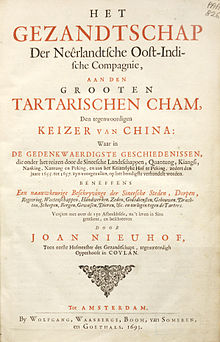Joan Nieuhof
Johan Nieuhof or Joan Nieuhoff (born July 22, 1618 in Uelsen , † October 8, 1672 in Madagascar ) was a Dutch globetrotter .
Nieuhof as a globetrotter
His father Jan Nijhoff, who came from Zwolle , was a merchant and mayor of the community of Uelsen in the county of Bentheim . His mother Egberta Piccardt was a sister of Johan Picardt . Since Nieuhof went to Brazil as an ensign in the service of the Dutch West-Indian Company in 1640 , he has lived outside Europe. He traveled to India , Sri Lanka , China and Indonesia in the service of the East Indian Company and as a private individual . Only twice, in 1658 and 1671, did he return to the Netherlands for brief family visits.
Nieuhof in Brazil
Nieuhof stayed in Brazil from 1640 to 1649. It was the time when the Dutch West Indian Company tried to take over the Portuguese trade bases. In contrast to Indonesia, the Portuguese managed to reverse the initial successes of the Dutch and thus keep Brazil to themselves.
Nieuhof in China
Nieuhof got to know China as a member of a Dutch delegation to the Imperial Court of Beijing (1655–1657). The long journey from Canton to Beijing , by land and water, is the subject of the first part of Nieuhof's China Report. The second part of Nieuhof's China book is devoted to a systematic description of “the country and its people ” and the history of the country.
Nieuhof's China book " Het Gezandtschap der Neêrlandtsche Oost-Indische Compagnie, aan the great Tartarian Cham, the Tegenwoordigen Keizer van China " (German: " The embassy of the Dutch East India Company to the great Tartar Khan, the current Emperor of China ") was a Best seller, although it was quite expensive due to the numerous engravings . How enthusiastically the book was received by the European readership is illustrated by the many editions - five Dutch (1665, 1669, 1670, 1680 and 1693), three German (1666, 1669 and 1675), two English (1669 and 1673), one French (1665) and one in Latin (1668) and another in Dutch (1666).
Two reasons may explain the popularity of the book at the time: It gave the most comprehensive account of China to date, based on Nieuhof's own observations as well as the most important and Jesuit sources of the time. In addition, the 150 copperplate engravings conveyed the most realistic visual image of China to date to the European reader.
Nieuhof in India
Nieuhof came to India in the early 1660s. He belonged to the armed forces of the East India Company that took a number of trading cities on the south coast of India from the Portuguese.
From 1663 to 1666 he was director of the company branches on the Malabar coast. But then there were disputes with the Governor General in Batavia. First Nieuhof was transferred to Sri Lanka, in 1667 he resigned from the company.
Nieuhof's experiences in India and Indonesia appeared in a separate work, which was tied together in one volume with the work on "West India" (Brazil). Nieuhof's reports on India and Indonesia are all the more valuable as a source, as he knew many of the areas described from his own experience and in these cases did not have to fall back on older literature. Johan Nieuhof provided one of the best descriptions of old Batavia , where he lived as a private person from 1667 to 1670.
In 1672 the ship on which he went to Batavia anchored off Madagascar . Together with a landing party, Nieuhof went ashore to look for drinking water and was lost with his companions.
Because of his wanderlust, Joan Nieuhof never had the time to write a book. His brother Hendrik worked out and published his three works on the basis of his notes.
These 150 stitches were at the origin of the chinoiserie . Artists and architects like Johann Bernhard Fischer von Erlach were inspired by these engravings. The engravings were not found again until 1984. They were found in the collection of the anthropologist Roland Bonaparte (1858–1924). He had collected about Madagascar, but also about Lapland and the American Indians.
Web links
literature
- Blusse, L. & R. Falkenburg (1987) Johan Nieuwhofs beelden van een Chinareis, 1655–1657.
- Joan Nieuhof: Het Gezandtschap of the Neêrlandtsche Oost-Indische Compagnie, aan the great Tartarian Cham, the Tegenwoordigen Keizer van China: Waarin de most memorable divorced, who or the irritation door de Sineesche landtschappen, Quantung, Beijing, Kiangsi, Nanking, en Xantung en het Keizerlijke Hof te Peking, sedert den jaren 1655 dead 1657 zijn voorgevallen, op het bondigste negotiated. Beneffens een Naukeurige Beschrijvinge of the Sineesche Steden, Dorpen, Regeering, Weetenschappen, Hantwerke, Zeden, Godsdiensten, Gebouwen, Drachten, Schepen, Bergen, Gewassen, Dieren, etcetera en oorlogen tegen de Tartars. 5th edition, Amsterdam: Wolfgang, Waasberge, Boom, van Somerten, en Goethals, 1693. Digitized
- Johan Nieuhof: Zee- en Lant-Reise door different vestiges of East India, hating veele zeldzaame en wonderlijke voorvallen en divorced. Beneffens een Beschrijving van lantschappen, dieren, Gewassen, Draghten, Zeden en godsdienst der inwoonders: A peculiarity een wijtloopig verhael the city of Batavia. Amsterdam: de Weduwe van Jacob van Meurs, 1682.
- Johan Nieuhof, Gedenkweerdige Brasiliaense Zee- en Lant-Reise and Zee- en Lant-Reize door various vestiges of East India. Amsterdam: de Weduwe van Jacob van Meurs, 1682. Digitized
- Friedrich Ratzel : Neuhof, Johann . In: Allgemeine Deutsche Biographie (ADB). Volume 23, Duncker & Humblot, Leipzig 1886, pp. 507-509.
| personal data | |
|---|---|
| SURNAME | Nieuhof, Joan |
| ALTERNATIVE NAMES | Johan Nieuhoff |
| BRIEF DESCRIPTION | Dutch "globetrotter" |
| DATE OF BIRTH | July 22, 1618 |
| PLACE OF BIRTH | Uelsen |
| DATE OF DEATH | October 8, 1672 |
| Place of death | in Madagascar |


